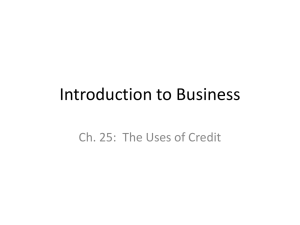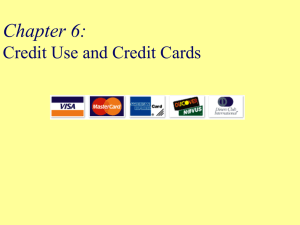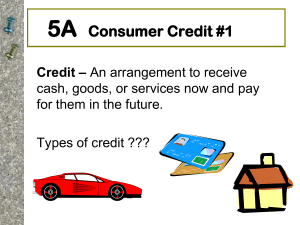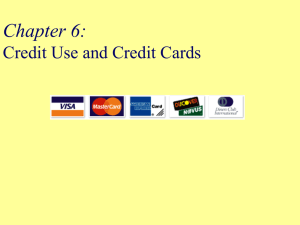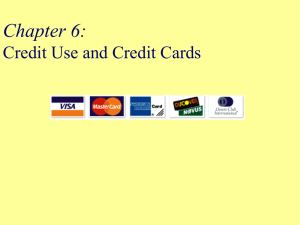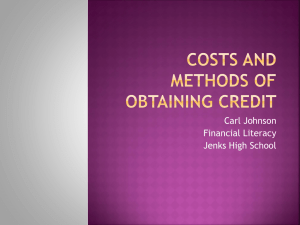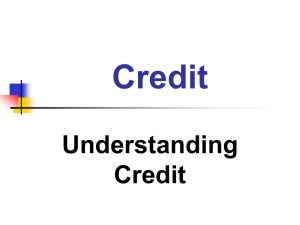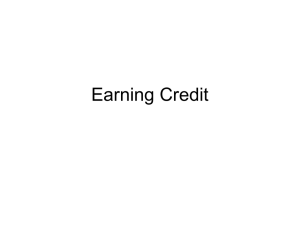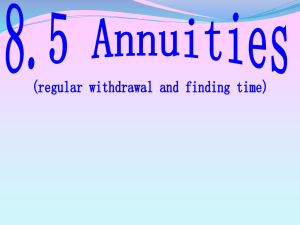Credit Fundamentals
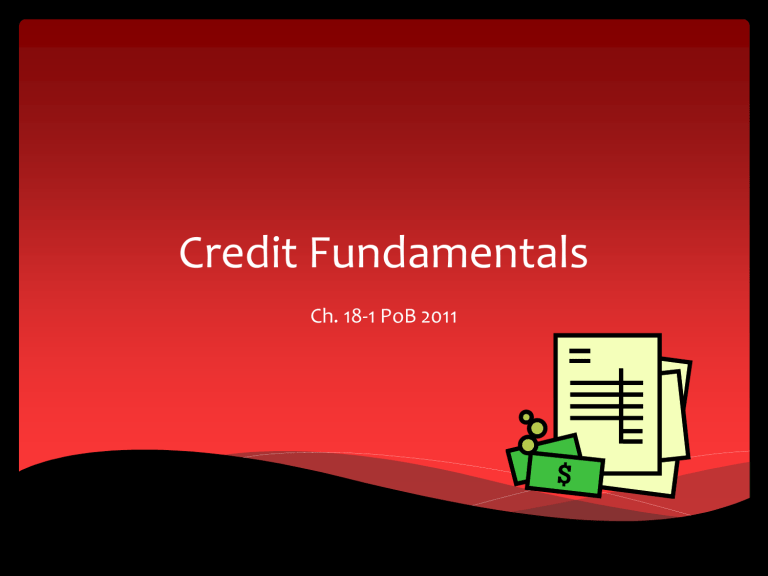
Credit Fundamentals
Ch. 18-1 PoB 2011
Using Credit
Credit – is the privilege of using someone else’s money for a period of time
Two parties are involved in a credit transaction:
Debtor – anyone who buys on credit or receives a loan
Creditor – the one who sells on a credit or makes a loan
Types of Credit
Trade Credit – occurs when a company receives goods from a supplier and pays for them later
Secure long-term loans
Borrow money for shorter period, 30 to 90 days
Loan Credit – if you borrow money for some special purpose
Involve a written contract
The borrower agrees to pay the loan in specified amounts, called
installments, over a period of time
Sales Credit – If you charge a purchase at the time you buy the good or service
Involves the use of charge accounts and credit cards
Charge Accounts
Charge Account – represents a contract between the firm offering the account and the customer
Three type of charge accounts:
Regular Accounts – requires the buyer to make full payment within a stated period – usually 25 to 30 days
Budget Accounts – requires that a customer make payments of a fixed amount of several months
Revolving Accounts – you may charge purchases at any time, but only part of the debt must be paid each month
Most popular form of sales credit
Credit Limit – a maximum amount may be owed at one time
Finance Charge – is the total dollar cost of credit, including interest and all other charges
Credit Cards
Bank Cards
Most popular all over the world
MasterCard and Visa are the best known
Sometimes you must pay an annual fee
Most credit card processing is done through Independent Sales
Organizations (ISOs)
Charge Cards
American Express and Diners Club are widely used
Subscribers pay a yearly fee that is higher than the fee for bank cards
No spending limit
Offer proof of traveling expenses
Credit Cards
Affinity Cards
Are co-branded with an issuing bank
All an organization, sports team, or other business to receive a small percentage of credit sales
Retail Store Cards
Many retail stores off their own credit cards to customers
Shows the name of the store that issued them
Can only use this card at the issuing store
Installment Credit
Installment Credit Sales – is a contract issued by the seller that requires periodic payments at specified times
Seller adds finance charges to the cost of items purchased
Credit agreement shows the total amount to be paid
Contractual agreement directly between seller and buyer
Installment Credit
Following are some features of installment credit:
Signing a sales contract that shows the terms of the purchase
Receiving the purchased item at time of sale
Be aware the seller has the right to repossess an item if payments are not made on time
Making a down payment, which is a payment of part of the purchase price
Paying a finance charge on the amount owed
Making regular payments at stated times
Penalties may be charged if a payment is received after the due date
Consumer Loans
Loan – is an alternative to charge account buying or installment sales credit
Installment Loan – is one in which you agree to make monthly payments in specific amounts over a period of time
Total amount you repay includes the amount you borrowed plus the finance on your loan
Single-Payment Loan – you do not pay until the end of the loan period
At that time, you’ll repay the full amount borrowed plus the finance charge
Consumer Loans
Promissory Note – is a written promise to repay based on a debtor’s excellent credit history
The amount borrowed, with interest, is due on a certain date
Promissory Notes should include the following components:
Principal – the amount that is promised to be paid
Time – the days or months from the date of the note until it should be paid
Date of Maturity – the date on which the note is due
Payee – the one to whom the note is payable
Interest Rate – the rate paid for the use of the money
Maker – the one who promises to make payment
Consumer Loans
Promissory Note (continued)
The lender may ask you to offer some property you own as security
Collateral – property that is used as security
You give the lender the right to sell this property to get back the amount of the loan if you do not repay it – Secured Loan
If you do not have an established credit history or any property or a good credit history, you may be able to get a relative or friend who has property or good credit history to sign you note, known as a co-signer
The co-signer of a note is responsible for payment of the note if you do not pay as promised
Benefits of Credit
The main advantages of credit for consumers include the following:
Convenience – can make it easy for you to buy
Immediate Possession – allows you to have the item now
Savings – allows to buy an items on sale at a good price
Credit Rating – a person’s reputation for paying bills on time is know as a Credit Rating
Useful for Emergencies – access to credit can help in unexpected situations
Credit Concerns
Overbuying
A common spending hazard of credit involves buying something that is more expensive than you can afford
Careless Buying
If you become impatient or distracted in your shopping, you may not shop carefully
Higher Prices
Stores that only accept cash may sell items at lower prices than stores that offer credit
Overuse of Credit
Buying now and paying later may sound like a good idea, but if too many payments need to be made later, the total amount owed becomes a problem
Questions to Ask
How will you benefit from this use of credit?
Is this the best buy you can make or should you shop around?
What will be the total cost of your purchase, including the finance charge?
What would you save if you paid cash?
Will the payments be too high for your income?
Review
1.
What are the major types of consumer credit?
2.
What are the main advantages of consumer credit?
3.
